A product costs USD10 when purchased in the USA. The same product costs USD12 when it is purchased in the UK and the price in GBP is convened to USD.
Which of the following statement concerning purchasing power parity is correct?
A company plans to raise S15 million to finance an expansion project using a rights issue Relevant data
• Shares will be offered at a 20% discount to the present market price of S12 50 per share
• There are currently 3 million shares in issue
• The project is forecast to yield a positive NPV of $9 million
What is the yield-adjusted Theoretical Ex-Rights Price following the announcement of the rights issue?
A UK based company is considering investing GBP1 ,000,000 in a project it the USA. It is anticipated that the project will yield net cash inflows of USD580.000 each year for the next three years. These surplus cash flows will be remitted to the UK at the end of each year.
Currently GBP1.00 is worth USD1.30.
The expected inflation rates in the two countries over the next four years are 2% in the UK and 4% in the USA.
Applying the purchasing power parity theory, which of the following represents the expected remittance at the end of year three, in GBP whole the nearest whole GBP)?
A company generates and distributes electricity and gas to households and businesses.
Forecast results for the next financial year are as follows:

The Industry Regulator has announced a new price cap of $2.00 per Kilowatt.
The company expects this to cause consumption to rise by 15% but costs would remained unaltered.
The price cap is expected to cause the company's net profit to fall to:
Company ABE is an unlisted company that has been trading for 10 years. During this period, it has seen substantial growth in revenue and earnings. For the company to continue its growth it needs to raise new finance The directors are considering an initial public offering (IPO).
The following information is relevant to Company ABE:

A listed company of similar size and in the same industry as Company ABE had earnings per share in the last financial year of $1 80 Its shares are currently trading at a price / earnings ratio of 12.
The directors of Company ABE have asked for advice on what price they might expect if the company is listed on the stock exchange by means of an IPO.
Using the information provided what is an estimated issue price for each share in Company ABE?

Give your answer to 2 decimal places.
The primary objective of a public sector entity is to ensure value for money is generated.
Value for money is defined as performing an activity so as to simultaneously achieve economy, efficiency and effectiveness
Efficiency is defined as:
A listed company is planning a share repurchase.
The following data applies:
• There are 10 million shares in issue
• The share repurchase will involve buying back 20% of the shares at a price of $0.75
• The company is holding $2 million cash
• Earnings for the current year ended are $2 million
The Directors are concerned about the impact that this repurchase programme will have on the company's cash balance and current year earnings per share (EPS) ratio.
Advise the directors which of the following statements is correct?
A company is considering whether to lease or buy an asset.
The following data applies:
• The bank will charge interest at 7.14% per annum
• The asset will cost $1 million
• Tax-allowable depreciation is available on a straight line basis over 5 years
• There is no residual value
• Corporate tax is paid at 30% in the year when the profit is earned
What is the NPV of the buy option?
Give your answer to the nearest $000.
$ ?
Which THREE of the following are considered in detail in IFRS 7 Financial Instruments: Disclosures?
Which THREE of the following statements about stock market listings are correct?
A company intends to sell one of its business units, Company R by a management buyout (MBO).
A selling price of $100 million has been agreed.
The managers are discussing with a bank and a venture capital company (VCC) the following financing proposal:
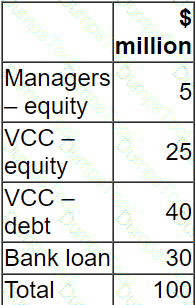
The VCC requires a minimum return on its equity investment in the MBO of 30% a year on a compound basis over 5 years.
What is the minimum TOTAL equity value of Company R in 5 years time in order to meet the VCC's required return?
Give your answer to one decimal place.
$ ? million
Company BBB has prepared a valuation of a competitor company, Company BBD. Company BBB is intending to acquire a controlling interest in the equity of Company BBD and therefore wants to value only the equity of Company BBD.

The directors of Company BBB have prepared the following valuation of Company BBD:
Value of Equity = 4.63 + 5.14 + 5.56 = S15.33 million
Additional information on Company BBD:

Which THREE of the following are weaknesses of the above valuation?
The Board of Directors of a listed company wish to estimate a reasonable valuation of the entire share capital of the company in the event of a takeover bid.
The company's current profit before taxation is $10 0 million.
The rate of corporate tax is 20%.
The average P/E multiple of listed companies in the same industry is 10 times current earnings.
The P/E multiple of recent takeovers in the same industry have ranged from 11 times to 12 times current earnings.
The average P/E multiple of the top 100 companies on the stock market is 16 times current earnings.
Advise the Board of Directors which of the following is a reasonable estimate of a range of values of the entire share capital in the event of a bid being made for the whole company?
Which TWO of the following situations offer arbitrage opportunities?
A)

B)

C)

D)

Company W is a manufacturing company with three divisions, all of which are making profits:
• Division A which manufactures cars
• Division B which manufactures trucks
• Division C which manufactures agricultural machinery
Company W is facing severe competitive pressure in all of its markets, and is currently operating with a high level of gearing Company W's latest forecasts suggest that it needs to raise cash to avoid breaching loan covenants on its existing debt finance in 6 months' time
In a recent strategy review. Divisions A and B were identified as being the core divisions of Company W
The management of Division C is known to be interested in the possibility of a management buy-out. Company Z is known to be interested in making a takeover bid for Company W's truck manufacturing division
A rival to Company W has recently successfully demerged its business, this was well received by the Financial markets
Which of the following exit strategies will be most suitable for company W?
Where a company acquires another company, which THREE of the following offer the greatest potential for enhancing shareholder wealth?
A company's current earnings before interest and taxation are $5 million.
These are expected to remain constant for the forseeable future.
The company has 10 million shares in issue which currently trade at $3.60.
It also has a $10 million long term floating rate loan.
The current interest rate on this loan is 5%.
The company pays tax at 20%.
The company expects interest rates to increase next year to 6% and it's Price/Earnings (P/E) ratio to move to 9.5 times by the end of next year.
What percentage reduction in the share price will occur by the end of next year if the interest rate increase and the P/E movement both occur?
A company has convertible bonds in issue.
The following debt is apply (31 December 20X0):
• Conversion ratio- 20 shares for each $130 bond.
• Current share price - $4 50
• Expected annual growth in share price - 5%
Advise the bond Holder at which date the convers on would be worthwhile?
A company is currently all-equity financed with a cost of equity of 8%.
It plans to raise debt with a pre-tax cost of 4% in order to buy back equity shares.
After the buy-back, the debt-to-equity ratio at market values will be 1 to 2.
The corporate income tax rate is 30%.
Which of the following represents the company's cost of equity after the buy-back according to Modigliani and Miller's Theory of Capital Structure with taxes?
A company wishes to raise additional debt finance and is assessing the impact this will have on key ratios.
The following data currently applies:
• Profit before interest and tax for the current year is $500,000
• Long term debt of $300,000 at a fixed interest rate of 5%
• 250,000 shares in issue with a share price of $8
The company plans to borrow an additional $200,000 on the first day of the year to invest in new project which will improve annual profit before interest and tax by $24,000.
The additional debt would carry an interest rate of 3%.
Assume the number of shares in issue remain constant but the share price will increase to $8.50 after the investment.
The rate of corporate income tax is 30%.
After the investment, which of the following statements is correct?
Company A has agreed to buy all the share capital of Company B.
The Board of Directors of Company A believes that the post-acquisition value of the expanded business can be computed using the "boot-strapping" concept.
Which of the following most accurately describes "boot-strapping" in this context?
Company X is an established, unquoted company which provides IT advisory services.
The company's results and cashflows are growing steadily and it has few direct competitors due to the very specialised nature of it's business. Dividends are predictable and paid annually.
Company P is looking to buy 30% of company X's equity shares.
Which TWO of the following methods are likely to be considered most suitable valuation methods for valuing company P's investment in Company X?
Which THREE of the following non-financial objectives would be most appropriate for a listed company in the food retailing industry?
An all-equity financed company currently generates total revenue of $50 million.
Its current profit before interest and taxation (PBIT) is $10 million.
Due to difficult trading conditions, the company expects its total revenue to be constant next year, although some margins will reduce.
It forecasts next year's PBIT will fall to 18% on 40% of its revenue, but that the PBIT on the other 60% of its revenue will be unaffected.
The rate of corporate tax is 20%.
What is the forecast percentage reduction in next year's Earnings?
A young, capital intensive company has a large amount of tangible assets.
Intangibles, including brand name, are considered to be of negligible value at this time
Relevant data:
• The company operates a residual dividend policy.
• The industry in which the company operates is suffering from a large amount of uncertainty at present. Forecasting the future earnings or cashflows of the company is therefore extremely difficult
• There are very few quoted companies in the industry that are similar in size or in precisely the same business sectors.
Which method of valuation would be most suitable for this company?
A profit-seeking company intends to acquire another company for a variety of reasons, primarily to enhance shareholder wealth.
Which THREE of the following offer the greatest potential for enhancing shareholder wealth?
A venture capitalist is considering investing in a management buy-out that would be financed as follows:
• Equity from managers
• Equity from a venture capitalist
• Mezzanine debt finance from a venture capitalist
• Senior debt from a bank
The venture capitalist is planning to work with the management to grow the business in anticipation of an initial public offering within five years.
However, the cash forecast shows a potential shortage of funds in the first year and the venture capitalist is evaluating the potential impact of cash being generated in the first year being significantly lower than forecast.
The most important risk that a shortage of cash would create for the management buyout is that the new company has insufficient funds to:
G purchased a put option that grants the right to cap the interest on a loan at 10.0%. Simultaneously, G sold a call option that grants the holder the benefits of any decrease if interest rates fall below 8.5%.
Which THREE possible explanations would be consistent with G's behavior?
A company proposes to value itself based on the net present value of estimated future cash flows.
Relevant data:
• The cash flow for the next three years is expected to be £100 million each year
• The cash flow after year 3 will grow at 2% to perpetuity
• The cost of capital is 12%
The value of the company to the nearest $ million is:
A company needs to raise $20 million to finance a project.
It has decided on a rights issue at a discount of 20% to its current market share price.
There are currently 20 million shares in issue with a nominal value of $1 and a market price of $5 per share.
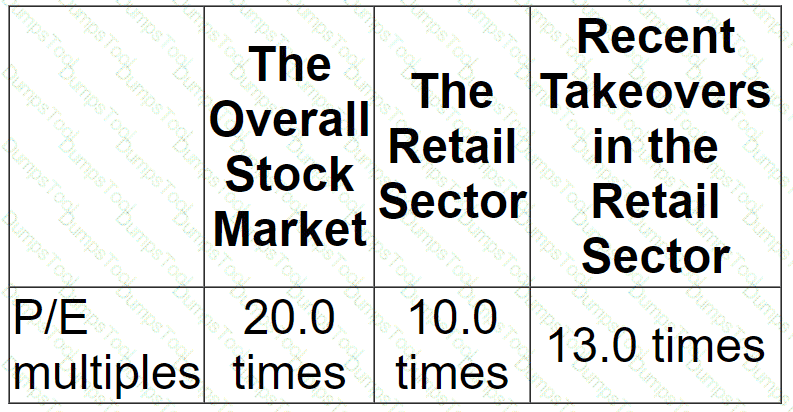
Calculate the terms of the rights issue.
A major energy company, GDE, generates and distributes electricity in country A. The government of country A is concerned about rising inflation and has imposed price controls on GDE, limiting the price it can charge per unit of electricity sold to both domestic and commercial customers. It is likely that price controls will continue for the foreseeable future.
The introduction of price controls is likely to reduce the profit for the current year from $3 billion to $1 billion.
The company has:
• Distributable reserves of $2 billion.
• Surplus cash at the start of the year of $1 billion.
• Plans to pay a total dividend of $1.5 billion in respect of the current year, representing a small annual increase as in previous years. However, no dividends have yet been announced.
Which THREE of the following responses would be MOST appropriate for GDE following the imposition of price controls?
A company has 8% convertible bonds in issue. The bonds are convertible in 3 years time at a ratio of 20 ordinary shares per $100 nominal value bond.
Each share:
• has a current market value of $5.60
• is expected to grow at 5% each year
What is the expected conversion value of each $100 nominal value bond in 3 years' time?
A publicly funded school is focused on providing Value for Money
It pays its leaching staff less than other schools, because class sizes are generally smaller than elsewhere Despite some staff demotivation from low pay, exam pass rates are high given the close one-to-one attention many pupils receive.
On which aspect of Value for Money is the school underperforming?
Company P is a pharmaceutical company listed on an alternative investment market.
The company is developing a new drug which it hopes to market in approximately six years' time.
Company P is owned and managed by a group of doctors who wish to retain control of the company. The company operates from leased laboratories with minimal fixed assets.
Its value comes from the quality of its research staff and their research.
The company currently has one approved drug which generates sufficient cashflow to cover day to day operations but not sufficient for major new research and development.
Company P wish to raise debt finance to develop the new drug.
Recommend which of the following types of debt finance would be most appropriate for Company P to help finance the development of this new drug.
Company A, a listed company, plans to acquire Company T, which is also listed.
Additional information is:
• Company A has 150 million shares in issue, with market price currently at $7.00 per share.
• Company T has 120 million shares in issue,. with market price currently at $6.00 each share.
• Synergies valued at $50 million are expected to arise from the acquisition.
• The terms of the offer will be 2 shares in A for 3 shares in T.
Assuming the offer is accepted and the synergies are realised, what should the post-acquisition price of each of Company A's shares be?
Give your answer to two decimal places.

A venture capitalist invests in a company by means of buying:
• 9 million shares for $2 a share and
• 8% bonds with a nominal value of $2 million, repayable at par in 3 years' time.
The venture capitalist expects a return on the equity portion of the investment of at least 20% a year on a compound basis over the first 3 years of the investment.
The company has 10 million shares in issue.
What is the minimum total equity value for the company in 3 years' time required to satisify the venture capitalist's expected return?
Give your answer to the nearest $ million.
$ million.
Company A operates in country A and uses currency AS. It is looking to acquire Company B which operates in country B and uses currency B$. The following information is relevant:

The assistant accountant at Company A has prepared the following valuation of company B's equity, however there are some errors in his calculations.

Value of Company B's equity = 14.16 + 16.03 + 17.67 = AS47.86 million
Company B has BS5 million of debt finance.
Which of the following THREE statements are true?
A company's gearing is well below its optimal level and therefore it is considering implementing a share re-purchase programme.
This programme will be funded from the proceeds of a planned new long-term bond issue.
Its financial projections show no change to next year's expected earnings.
As a result, the company plans to pay the same total dividend in future years.
If the share re-purchase is implemented, which THREE of the following measures are most likely to decrease?
A company in country T is considering either exporting its product directly to customers in country P or establishing a manufacturing subsidiary in country P.
The corporate tax rate in country T is 20% and 25% tax depreciation allowances are available
Which TIIRCC of the following would be considered advantages of establishing a subsidiary in country T?
A company based in the USA has a substantial fixed rate borrowing at an interest rate of 3.5% and wishes to swap a part of this to a floating rate to take advantage of reducing interest rates Its bank has quoted swap rates of 3 4%-3 5% against 12-month USD risk-free rate.
What is the overall interest rate achieved by the company under this borrowing plus swap combination?
Company M is a geared company whose equity has a market value of $1,500 million and debt has a market value of S300 million. The company plans to issue $200 million of new shares and use the funds raised to pay off some of the debt
Company M currently has a cost of equity of 13% and a WACC of 10% It pays corporate tax at the rate of 30% Company B, an ungeared company operating in the same business sector as Company M, has a cost of equity of 12%
Assume Modigliani and Miller's theory of capital structure with tax applies
Which calculation below shows the correct approach to calculating the new WACC following the planned changes in capital structure?
A

B

C

D

Company Z has just completed the all-cash acquisition of Company A.
Both companies operate in the advertising industry.
The market considered the acquisition a positive strategic move by Company Z.
Which THREE of the following will the shareholders of Company Z expect the company's directors to prioritise following the acquisition?
M is an accountant who wishes to take out a forward rate agreement as a hedging instrument but the company treasurer has advised that a short-term interest rate future would be a better option.
Which of the following is true of a short-term interest rate future?
A new company was set up two years ago using the personal financial resources of the founders.
These funds were used to acquire suitable premises.
The company has entered into a long-term lease on the premises which are not yet fully fitted out.
The founders are considering requesting loan finance from the company's bank to fund the purchase of custom-made advanced technology equipment.
No other companies are using this type of equipment.
The company expects to continue to be profitable for the forseeable future.
It re-invests some of its surplus cash in on-going essential research and development.
Which THREE of the following features are likely to be considered negatives by the bank when assessing the company's credit-worthiness?
Company ABC is planning to bid for company DDD, an unlisted company in an unrelated industry sector to ABC.
The directors of ABC are considering a number of different valuation methods for DDD before making a bid.
Which of the following is the MOST appropriate method for ABC to use to value DDD?
Company M is a listed company in a highly technical service industry.
The directors are considering making a cash offer for the shares in Company Q, an unquoted company in the same industry.
Relevant data about Company Q:
• The company has seen consistent growth in earnings each year since it was founded 10 years ago.
• It has relatively few non-current assets.
• Many of the employees are leading experts in their field. A recent exercise suggested that the value of the company's human capital exceeded the value of its tangible assets.
The directors and major shareholders of Company Q have indicated willingness to sell the company.
Before negotiations become too advanced, the directors of Company M are considering the benefits to their company that would follow the acquisition.
Which THREE of the following are the most likely benefits of the acquisition to Company M's shareholders?
Companies L. M N and O:
• are based in a country that uses the RS as its currency
• have an objective to grow operating profit year on year
• have the same total levels of revenue and cost
• trade with companies or individuals in the United States. All import and export trade with companies or individuals in the United States is priced in US$.
Typical import/export trade for each company in a year are as follows:

Which company's growth objective is most sensitive to a movement in the USS / RS exchange rate?
Company XXY operates in country X with the X$ as its currency. It is looking to acquire company ZZY which operates in country Z with the Z$ as its currency.
The assistant accountant at Company XXY has started to prepare an initial valuation of Company ZZY's equity for the first 3 years, however their valuation is incomplete. TBC' in the table below indicates that her calculations have yet to be completed.
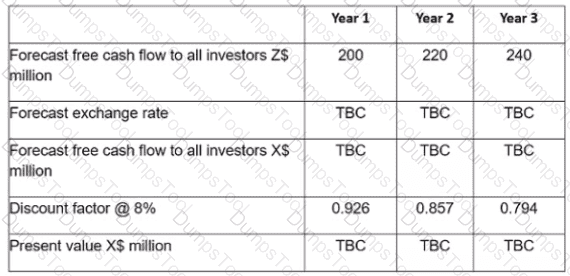
The following information is relevant:

What is the correct figure (to the nearest million S) to include in year 3 as the present value in X$ million?
Using the CAPM, the expected return for a company is 11%. The market return is 8% and the risk free rate is 2%.
What does the beta factor used in this calculation indicate about the risk of the company?
A large, listed company in the food and household goods industry needs to raise $50 million for a period of up to 6 months.
It has an excellent credit rating and there is almost no risk of the company defaulting on the borrowings. The company already has a commercial paper programme in place and has a good relationship with its bank.
Which of the following is likely to be the most cost effective method of borrowing the money?
Company J plans to acquire Company K, an unlisted company whose equity is to be valued using a P/E ratio approach.
A listed company has been identified which is very similar to Company K and which can be used as a proxy.
However, the growth prospects of Company K are higher than those of the proxy.
The Directors of Company J are aware that certain adjustments will be necessary to the proxy company's P/E ratio in order to obtain a more reliable valuation.
The following adjustments have been agreed:
• 20% due to Company K being unlisted.
• 15% to allow for the growth rate difference.
The total adjustment to the proxy p/e ratio is:
Company HJK is planning to bid for listed company BNM
Financial data for BNM for the financial year ended 31 December 20X1:

HJK is not forecasting any growth in these figures for the foreseeable future
Profit and cost data above should be assumed to be equivalent to cash flow data when answenng this question
Which THREE of the following approaches would be most appropriate for HJK to use to value the equity of BNM?
A company is considering a divestment via either a management buyout (MBO) or sale to a private equity purchaser. Which of the following is an argument in favour of the MBO from the viewpoint of the original company?
Which THREE of the following methods of business valuation would give a valuation of the equity of an entity, rather than the value of the whole entity?
A company has:
• $6 million market value of equity
• $4 million market value of debt
• WACC of 11.04%
• Corporate income tax rate of 20%
According to Modigliani and Miller's theory of capital structure with tax, what is the ungeared cost of equity?
XYZ has a variable rate loan of $200 million on which it is paying interest of Liber ‘3%.
XYZ entered into a swap with AG bank to convert this to a fixed rate 8% loan. AB bank charges an annual commission of 0.4% for making this arrangement
Calculate the net payment from KYZ to AB bank at the end of the first year if Libor was 2% throughout the year.
Give your answer in $ million, to one decimal place.

On 31 October 20X3:
• A company expected to agree a foreign currency transaction in January 20X4 for settlement on 31 March 20X4.
• The company hedged the currency risk using a forward contract at nil cost for settlement on 31 March 20X4.
• The transaction was correctly treated as a cash flow hedge in accordance with IAS 39 Financial Instruments: Recognition and Measurement.
On 31 December 20X3, the financial year end, the fair value of the forward contract was $10,000 (asset).
How should the increase in the fair value of the forward contract be treated within the financial statements for the year ended 31 December 20X3?
A company has some 7% coupon bonds in issue and wishes to change its interest rate profile.
It has decided to do this by entering into a plain coupon interest rate swap with it's bank.
The bank has quoted a swap rate of: 6.0% - 6.5% fixed against LIBOR.
What will the company's new interest rate profile be?
Company T is a listed company in the retail sector.
Its current profit before interest and taxation is $5 million.
This level of profit is forecast to be maintainable in future.
Company T has a 10% corporate bond in issue with a nominal value of $10 million.
This currently trades at 90% of its nominal value.
Corporate tax is paid at 20%.
The following information is available:
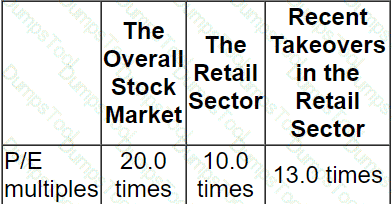
Which of the following is a reasonable expectation of the equity value in the event of an attempted takeover?
A company intends to sell one of its business units. Company W, by a management buyout (MBO). A selling price of S200 million has been agreed.
The managers are discussing with a bank and a venture capital company (VCC) the following financing proposal.
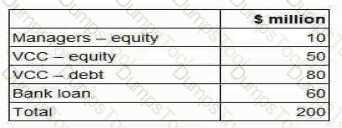
The VCC requires a minimum return on its equity investment In the MBO of 35% a year on a compound basis over 5 years. What is the minimum total equity value of Company W in 5 years time in order to meet the VCC's required return? Give your answer to one decimal place.

DFG is a successful company and its shares are listed on a recognised stock exchange. The company's gearing ratio is currently in line with the industry average and the directors of DFG do not want to increase the company's financial risk. The company does not carry a large cash balance and its shareholders are not expected to be willing to support a rights issue at this time
LMB is a small services company owned and managed by a small board of directors who are going to retire within the next year
DFG wishes to purchase LMB and has approached LMB's owners, who are broadly open to the proposal, to discuss the bid and the consideration to be offered by DFG. LMB's owners explain to DFG that they are also keen to defer any tax liabilities they would be subject to on receipt of the consideration.
Based on the information provided, which of the following types of consideration would be most suitable to finance the acquisition?
A company has undertaken a transaction with its shareholders which has had the following impact on its financial statements:
• Retained earnings has decreased
• Share capital has increased
• Earnings per share has decreased
• The book value of equity is unchanged
The company has undertaken a:
If a company's bonds are currently yielding 8% in the marketplace, why would the entity's cost of debt be lower than this?
ADC is planning to acquire DEF in order to benefit from the expertise of DEF's owner ‘managers Both are Listed companies. ADC is trying to decide whether to offer cash or shares in consideration for DEF's shares.
Which THREE of the following are advantages to ABC of offering shares to acquire CEF?
Delta and Kappa both wish to borrow $50m.
Delta can borrow at a fixed rate of 12% or at a floating rate of the risk-free rate +3%
Kappa can borrow at 15% fixed or the risk-free rate +4%.
Delta wishes a variable rate loan and Kappa a fixed rate loan The bank for the two companies suggests a swap arrangement The two companies agree to a swap arrangement, sharing savings equally
What is the effective swap rate for each company?
The shares of a company in a high technology industry have been listed on a stock exchange for 10 years. During this period, it has paid no dividends but invested all retained earnings in growth. The company is now entering a period of relatively stable growth and the directors are considering beginning to pay dividends They are reviewing the following suggestions made by members of the board:
• Pay cash dividends linked to growth in earnings
• Use a residual theory approach to establish cash dividends
• Issue scrip dividends (shares instead of cash)
• Continue to pay no dividends as dividends are irrelevant to the value of the company
Which THREE of the following are correct statements for the directors to take into consideration when making a decision about future dividend policy?
Company A is planning to acquire Company B. Both companies are listed and are of similar size based on market capitalisation No approach has yet been made to Company B's shareholders as the directors of Company A are undecided about the most suitable method of financing the offer Two methods are under consideration a share exchange or a cash offer financed by debt.
Company A currently has a gearing ratio (debt to debt plus equity) of 30% based on market values. The average gearing ratio (debt to debt plus equity) for the industry is 50% Although no formal offer has been made there have been market rumours of the proposed bid. which is seen as favorable to Company A. As a consequence. Company As share price has risen over the past few weeks while Company B's share price has fallen.
Which THREE of the following statements are most likely to be correct?
Company A plans to acquire a minority stake in Company B.
The last available share price for Company B was $0.60.
Relevant data about Company B is as follows:
• A dividend per share of $0.08 has just been paid
• Dividend growth is expected to be 2%
• Earnings growth is expected to be 4%
• The cost of equity is 15%
• The weighted average cost of capital is 13%
Using the dividend growth model, what would be the expected change in share price?
A company raised fixed rate bank finance together with an interest rate swap for the same term and same principal value to pay floating receive fixed rate interest on an annual basis.
Which THREE of the following statements are correct?
X exports goods to customers in a number of small countries Asia. At present, X invoices customers in X's home currency.
The Sales Director has proposed that X should begin to invoice in the customers currency, and the Treasurers considering the implications of the proposal.
Which TWO of the following statement are correct?
A company is valuing its equity prior to an initial public offering (IPO).
Relevant data:
• Earnings per share $1.00
• WACC is 8% and the cost of equity is 12%
• Dividend payout ratio 40%
• Dividend growth rate 2% in perpetuity
The current share price using the Dividend Valuation Model is closest to:
A company is concerned about the interest rate that it will be required to pay on a planned bond issue.
It is considering issuing bonds with warrants attached.
Advise the directors which of the following statements about warrants is NOT correct?
Which THREE of the following would be most important if a hospital wishes to review the effectiveness of its services?
The following information relates to Company ZZA's current capital structure:

Company ZZA is considering a change in the capital structure that will increase gearing to 35:65 (Debt Equity).
The risk-free rate is 4% and the return on the market portfolio is expected to be 12%.
The rate of corporate tax is 25%
Using the Capital Asset Pricing Model, calculate the cost of equity resulting from the proposed change to the capital structure.
A company's latest accounts show profit after tax of $20.0 million, after deducting interest of $5.0 million. The company expects earnings to grow at 5% per annum indefinitely.
The company has estimated its cost of equity at 12%, which is included in the company WACC of 10%.
Assuming that profit after tax is equivalent to cash flows, what is the value of the equity capital?
Give your answer to the nearest $ million.
$ ? million
A company has a loss-making division that it has decided to divest in order to raise cash for other parts of the business.
The losses stem from a combination of a lack of capital investment and poor divisional management.
The loss-making division would require new capital investment of at least $20 million in order to replace worn out and obsolete assets.
If this investment was carried out, the present value of the future cashflows, excluding the investment expenditure, is expected to be $15 million.
Which TWO of the following divestment methods are most likely to be suitable for the company?
Company GDD plans to acquire Company HGG, an unlisted company which has been in business for 3 years.
Company HGG has incurred losses in its first 3 years but is expected to become highly profitable in the near future
There are no listed companies in the country operating in the same business field as Company HGG The future success of Company HGG's business and hence the future growth rate in earnings and dividends is difficult to determine
Company GDD is assessing the validity of using the dividend growth method to value Company HGG
Which THREE of the following are weaknesses of using the dividend growth model to value an unlisted company such as Company HGG?
A company is planning a new share issue.
The funds raised will be used to repay debt on which it is currently paying a high interest rate.
Operating profit and dividends are expected to remain unchanged in the near future.
If the share issue is implemented, which THREE of the following are most likely to increase?
A national airline has made an offer to acquire a smaller airline in the same country.
Which of the following would be of most concern to the competition authorities?
Company X plans to acquire Company Y.
Pre-acquisition information:
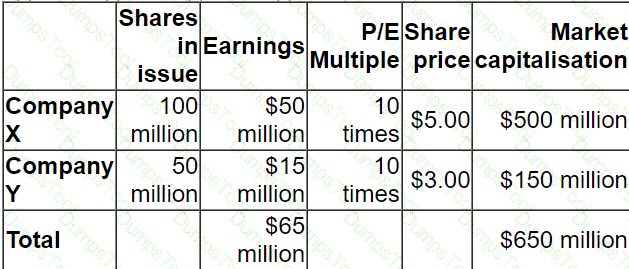
Post-acquisition information:
Total combined earnings are expected to increase by 10%
Total combined P/E multiple will remain at 10 times
Which of the following share-for-share exchanges will result in an increase of 10% in Company X's share price post-acquisition?
WW is a quoted manufacturing company. The Finance Director has addressed the shareholders during WW's annual general meeting-She has told the shareholders that WW raised equity during the year and used the funds to repay a large loan that was maturing, thereby reducing WW's gearing ratio
At the conclusion of the Finance Director's speech one of the shareholders complained that it had been foolish for WW to have used equity to repay debt The shareholder argued that the Modigliani and Miller model (with tax) offers proof that debt is cheaper than equity when companies pay tax on their profits.
Which THREE arguments could the Finance Director have used in response to the shareholder?
A company is financed by debt and equity and pays corporate income tax at 20%.
Its main objective is the maximisation of shareholder wealth.
It needs to raise $200 million to undertake a project with a positive NPV of $10 million.
The company is considering three options:
• A rights issue.
• A bond issue.
• A combination of both at the current debt to equity ratio.
Estimations of the market values of debt and equity both before and after the adoption of the project have been calculated, based upon Modigliani and Miller's capital theory with tax, and are shown below:
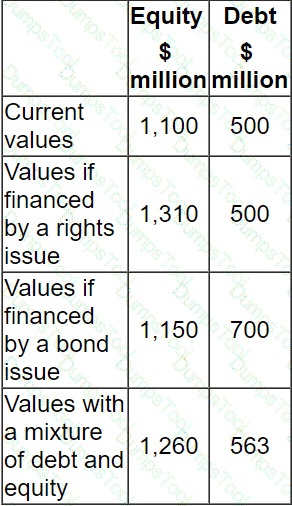
Under Modigliani and Miller's capital theory with tax, what is the increase in shareholder wealth?
Company S is planning to acquire Company T.
The shareholders in Company T will receive new shares in Company S in an all-share consideration.
Relevant information:
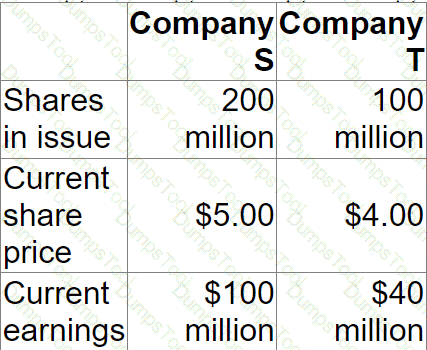
The shareholders in Company T want sufficient shares to receive a 25% premium on the pre-acquisition value of their shares, based on the pre-acquisition share price.
Which of the following share-for-share offers will achieve the desired result?
The directors of a unlisted manufacturing company have prepared a valuation of their company using the price-earning method.
Their calculation is:
Value if the company‘s equity = $6 million x 10 =$60 million where.
$6 million is the company’s reported profit before interested and tax in the most recent accounting period and
10 is the average price-earnings ratio for all listed companies
Which THREE of the following are weakness of this valuation?
A company has:
• $7 million market value of equity
• $5 million market value of debt
• WACC of 9.375%
• Corporate income tax rate of 15%
According to Modigliani and Miller's theory of capital structure with tax, what is the ungeared cost of equity?
A company based in Country A with the A$ as its functional currency requires A$500 million 20-year debt finance to finance a long-term investment The company has a high credit rating, but has not previously issued corporate bonds which are listed on the stock exchange Which THREE of the following are advantages of issuing 20 year bonds compared with simply borrowing for a 20 year period?
Company R is a major food retailer. It wishes to acquire Company S, a food manufacturer.
Company S currently supplies many stores owned by Company R with food products that it manufactures.
Company S is of similar size to Company R but has a lower credit rating.
Which of the following is most likely to be a synergistic benefit to R on purchasing S?
Company AD is planning to acquire Company DC. It is evaluating two methods of structuring the terms of the bid, which will be ether a debt-funded cash offer or a share exchange
The following Information is relevant
• The two companies are of similar size and in related industries
• AB's gearing ratio measured as debt to debt plus equity, is currently 30% based on market values. This Is the company's optimum capital structure set to reflect the risk appetite of shareholders.
• The combined company is expected to generate savings and synergies
Which THREE of the following are advantages to AB's shareholders of a debt-funded cash offer compared with a share exchange?
For which THREE of the following risk categories does IFRS 7 require sensitivity analysis?
A listed entertainment and media company produces and distributes films globally. The company invests heavily in intellectual property in order to create the scope for future film projects. The company has five separate distribution companies, each managed as a separate business unit The company is seeking to sell one of its business units in a management buy-out (MBO) to enable it to raise finance for proposed new investments
The business unit managers have been in discussions with a bank and venture capitalists regarding the financing for the MBO The venture capitalists are only prepared to invest a mixture of debt and equity and have suggested the following:

The venture capitalists have stated that they expect a minimum return on their equity investment of 3Q°/o a year on a compound basis over the first 5 years of the MBO No dividends will be paid during this period.
Advise the MBO team of the total amount due to the venture capitalist over the 5-year period to satisfy their total minimum return?
An all equity financed company reported earnings for the year ending 31 December 20X1 of $8 million.
One of its financial objectives is to increase earnings by 5% each year.
In the year ending 31 December 20X2 it financed a project by issuing a bond with a $1 million nominal value and a coupon rate of 4%.
The company pays corporate income tax at 20%.
If the company is to achieve its earnings target for the year ending 31 December 20X2, what is the minimum operating profit (profit before interest and tax) that it must achieve?
The International Integrated Reporting Council (IIRC) was formed in August 2010 and brings together a cross-section of representatives from a wide variety of business sectors.
The primary purpose of the IIRC's framework is to help enable an organsation to communicate how it:
CAPM:
E(R)=Rf+β(Rm−Rf)E(R) = R_f + \beta (R_m - R_f)E(R)=Rf+β(Rm−Rf)
Given:
E(R)=11%,Rf=2%,Rm=8%E(R) = 11\% , R_f = 2\%, R_m = 8\%E(R)=11%,Rf=2%,Rm=8%
0.11=0.02+β(0.08−0.02)⇒0.11−0.02=0.06β⇒0.09=0.06β⇒β=1.50.11 = 0.02 + \beta(0.08 - 0.02) \Rightarrow 0.11 - 0.02 = 0.06\beta \Rightarrow 0.09 = 0.06\beta \Rightarrow \beta = 1.50.11=0.02+β(0.08−0.02)⇒0.11−0.02=0.06β⇒0.09=0.06β⇒β=1.5
Beta > 1 ⇒ higher risk than the market.
A company's main objective is to achieve an average growth in dividends of 10% a year.
In the most recent financial year:
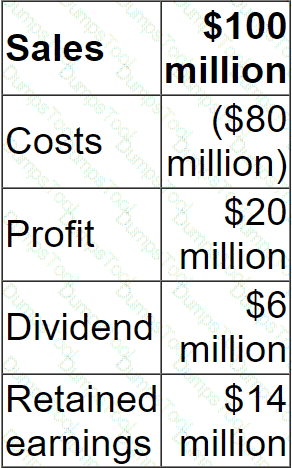
Sales are expected to grow at 8% a year over the next 5 years.
Costs are expected to grow at 5% a year over the next 5 years.
What is the minimum dividend payout ratio in 5 years' time that would allow the company to achieve its objective?
A listed company is financed by debt and equity.
If it increases the proportion of debt in its capital structure it would be in danger of breaching a debt covenant imposed by one of its lenders.
The following data is relevant:
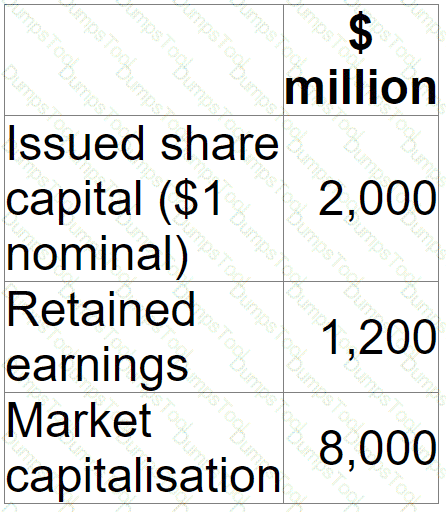
The company now requires $800 million additional funding for a major expansion programme.
Which of the following is the most appropriate as a source of finance for this expansion programme?
A listed company is financed by debt and equity.
If it increases the proportion of debt in its capital structure it would be in danger of breaching a debt covenant imposed by one of its lenders.
The following data is relevant:
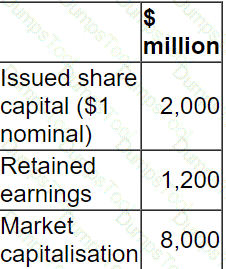
The company now requires $800 million additional funding for a major expansion programme.
Which of the following is the most appropriate as a source of finance for this expansion programme?
Company A is unlisted and all-equity financed. It is trying to estimate its cost of equity.
The following information relates to another company, Company B, which operates in the same industry as Company A and has similar business risk:
Equity beta = 1.6
Debt:equity ratio 40:60
The rate of corporate income tax is 20%.
The expected premium on the market portfolio is 7% and the risk-free rate is 5%.
What is the estimated cost of equity for Company A?
Give your answer to one decimal place.
? %
A company’s statement of financial position includes non-current assets which are leased, the tax regime follows the accounting treatment.
Which cash flows should be discounted when evaluating the cost of lease finance?
A company's annual dividend has grown steadily at an annual rate of 3% for many years. It has a cost of equity of 11%. The share price is presently $64.38.
The company is about to announce its latest dividend, which is expected to be $5.00 per share.
The Board of Directors is considering an attractive investment opportunity that would have to be funded by reducing the dividend to $4.50 per share. The board expects the project to enable future dividends to grow by 5% every year and the cost of equity to remain unchanged.
Calculate the change in share price, assuming that the directors announce their intention to proceed with this investment opportunity.
Give your answer to 2 decimal places.
$ ?
An unlisted company.
• Is owned by the original founders and members of their families
• Pays annual dividends each year depending on the cash requirements of the dominant shareholders.
• Has earnings that are highly sensitive to underlying economic conditions.
• Is a small business in a large Industry where there are listed companies with comparable capital structures
Which of the following methods is likely to give the most accurate equity value for this unlisted company?
A government is currently considering the privatisation of the national airline. The shares are to be offered to the public via a fixed price Initial Public Offering (IPO).
Which THREE of the following statements are correct?
Select whether the following statements are true or false with regard to Modigliani and Miller's dividend policy theory.

Which TIIRCC of the following are most likely to reduce the long term credit rating co a company?
Company A needs to raise AS500 mi lion to invest in a new project and is considering using a pub ic issue of bonds to finance the investment.
Which THREE of the following statements-relating to this bond issue are true?
WX, an advertising agency, has just completed the all-cash acquisition of a competitor, YZ. This was seen by the market as a positive strategic move byWX.
Which THREE of the following will WX's shareholders expect the company's directors to prioritise following the acquisition?
Company WWW is considering making a takeover bid for Company KKA Company KKA's current share price is $5.00
Company WWW is considering either
" A cash payment of $5.75 for each share in Company KKA
" A 5 year corporate bond with a market value of $90 in exchange for 15 shares in Company KKA
Calculate the highest percentage premium which Company KKA shareholders will receive.
An unlisted company has the following data:

A listed company in the same industry has a P/E of 11.
The value of the unlisted company based on the P/E of this listed company is:

Give your answer to the nearest whole number.
A company is preparing an integrated report according to the International
Which THREE of the following should be included in the report?
A listed company plans to raise new capital which will be required for future investment projects. The company has a gearing ratio of 50%, which is just below the company's target ratio.
The directors are comparing the benefits and drawbacks of each of the following two alternative sources of finance;
• Unsecured bank borrowings.
• Convertible bonds.
Which of the following statements is correct?